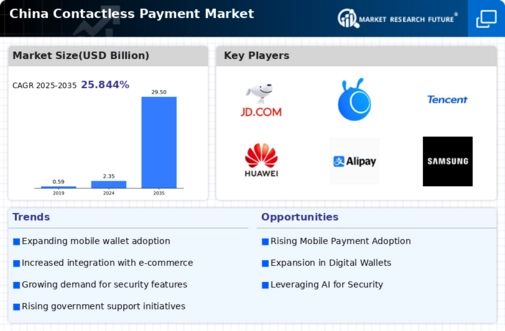Government Initiatives and Support
Government initiatives play a crucial role in shaping the contactless payment market in China. The Chinese government has actively promoted digital payment solutions as part of its broader strategy to enhance financial inclusion and modernize the economy. Policies encouraging the adoption of contactless payments have led to a notable increase in usage, with reports indicating that approximately 60% of the population now engages in contactless transactions. Furthermore, the government has invested in infrastructure development, ensuring that both urban and rural areas have access to necessary technology. This support not only boosts consumer confidence but also encourages businesses to adopt contactless payment systems, thereby expanding the market. The contactless payment market is likely to benefit from ongoing government backing, which may include subsidies for technology adoption and incentives for businesses that implement contactless solutions.
Consumer Preferences for Convenience
Consumer preferences in China are increasingly leaning towards convenience, significantly impacting the contactless payment market. As lifestyles become busier, individuals seek quick and efficient payment methods that minimize transaction times. Surveys indicate that over 80% of consumers prefer contactless payments for their speed and ease of use. This trend is particularly evident among younger demographics, who are more inclined to adopt new technologies. The contactless payment market is responding to this demand by enhancing user experiences through seamless integration with mobile applications and loyalty programs. Retailers are also adapting by offering incentives for contactless transactions, further driving adoption. As consumer preferences continue to evolve, the market is expected to expand, with businesses increasingly prioritizing contactless payment options to meet customer expectations.
Increased Focus on Health and Hygiene
In the context of health and hygiene, the contactless payment market in China is witnessing a notable transformation. Consumers are increasingly prioritizing contactless methods to minimize physical contact during transactions. This shift is reflected in the growing adoption of contactless payment solutions, with estimates suggesting that usage has increased by approximately 50% in various sectors, including retail and food services. Businesses are responding by implementing contactless payment systems to cater to consumer preferences for hygiene and safety. The contactless payment market is likely to continue evolving in response to these health-conscious trends, with innovations aimed at enhancing the user experience while ensuring safety. As awareness of hygiene continues to influence consumer behavior, the demand for contactless payment solutions is expected to remain robust.
Rise of E-commerce and Digital Transactions
The rise of e-commerce in China has had a profound impact on the contactless payment market. With online shopping becoming a staple for many consumers, the demand for efficient and secure payment methods has surged. In 2025, e-commerce transactions are projected to account for over 30% of total retail sales, with a significant portion facilitated through contactless payment solutions. This shift is prompting businesses to integrate contactless payment options into their online platforms, enhancing the overall shopping experience. The contactless payment market is likely to see continued growth as more consumers embrace digital transactions, leading to increased investment in technology and infrastructure. Additionally, partnerships between e-commerce platforms and payment providers are expected to flourish, further solidifying the role of contactless payments in the digital economy.
Technological Advancements in Payment Systems
The contactless payment market in China is experiencing a surge due to rapid technological advancements in payment systems. Innovations such as Near Field Communication (NFC) and QR code technology have streamlined transactions, making them faster and more efficient. In 2025, it is estimated that over 70% of transactions in urban areas utilize contactless methods, reflecting a significant shift in consumer behavior. The integration of biometric authentication further enhances security, fostering consumer trust in contactless payments. As technology continues to evolve, the contactless payment market is likely to see increased competition among providers, driving down costs and improving service offerings. This competitive landscape may lead to the development of new features, such as loyalty programs and personalized offers, which could further incentivize consumers to adopt contactless payment solutions.























Leave a Comment